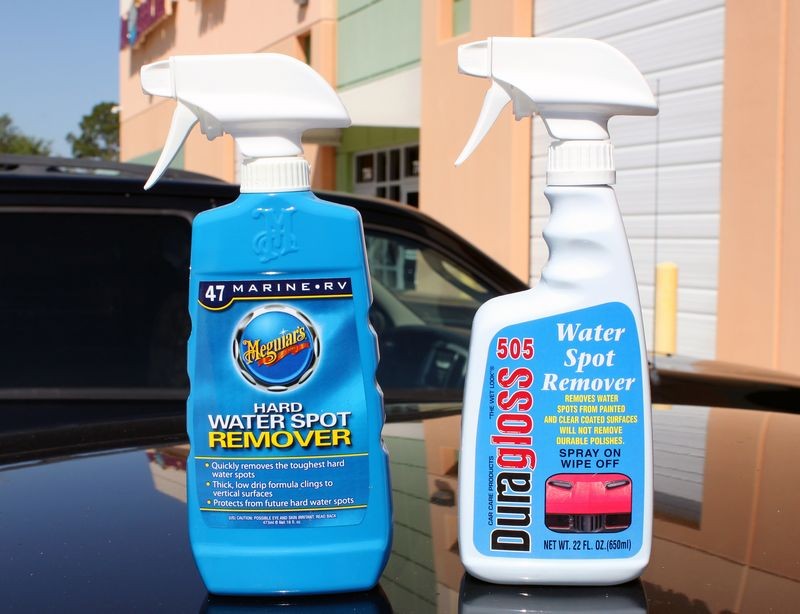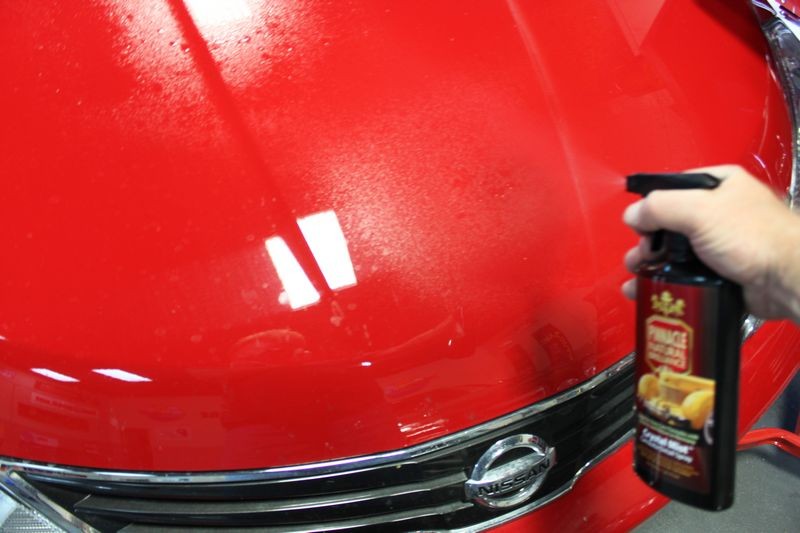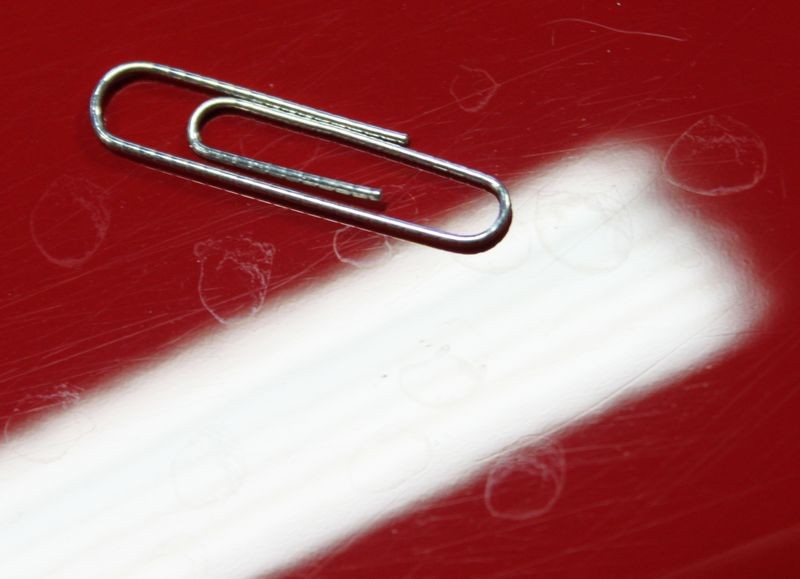 Thanks: 0
 Likes: 0
 Dislikes: 0
-
Super Member

Water Spots
What is the best way to remove water spots? They are on a red 2010 Hyundai Genesis Coupe. Vinegar? Clay? AIO? Polish?
-
Re: Water Spots
Hi Darren...
The best way depends upon what type of water spots you're dealing with. IF the spots are TOPICAL, that is simply a mineral deposit sitting on the surface then here's some suggestions and some information about the old passed around recommendation of using Vinegar.
Tips for removing Type I Water Spots
Meguiar's and Duragloss both make water spot removers that may work for Type I Water Spots.
Note: While Duragloss recommends their product for automotive finishes, Meguiar's only recommends their product for Marine and RV surfaces, so take this into consideration when choosing and using a product outside the manufactures recommendations.
I have successfully used M47 on automotive paints to remove mineral deposits but that does not mean it will work for you on your car for the type of mineral deposits or water spots on your car's finish. Always do a Test Spot and make sure you're getting the results you want and hope for.
Type I Water Spots = Topical
These are Mineral Deposits or what people commonly call "Hard Water Spots". It's the minerals in water that people are referring to when they use the word "hard" in the term "Hard Water Spots.
Type I Water Spots are primarily a mineral or dirt deposit laying on the surface of paint. Type I Water Spots can be the results of minerals suspended in city water or well water that are left behind after the water evaporates off the finish. This can happen by washing a car but not drying the water off the paint or if a sprinkler goes off next to the car covering the car with water drop that are not dried off the paint.
Type I Water Spots can also be dirt or pollution particles left behind after water from rain or inclement weather evaporates of the finish. Type I Water Spots can also be Type II Water Spots in that the water can leave both a deposit on the surface and an etching in the finish.
How To Remove
Type I Water Spots can usually be removed by washing or wiping the pant clean using a normal car wash, rinseless wash, waterless wash or spray detailer. There are also specialty products just for this including,
Specialty Products for removing water spots,
- Duragloss 505 Water Spot Remover
- Meguiar's M47 Marine-RV Hard Water Spot Remover

Duragloss 505 Water Spot Remover
The first sentence in the product description on the back of the Duragloss label reads,
Formulated to easily remove water spots caused by impurities, (CALCIUM), in water.
Duragloss states it can be used for automotive finishes and it won't remove durable polishes. My guess is they are using the word "polishes" generically to mean waxes, paint sealants or coatings, not abrasive products used to remove swirls and scratches. Duragloss calls all their paint sealants polishes. See the chapter on polishes for more information.
Meguiar's M47 Marine-RV Hard Water Spot Remover
The first sentence in the product description on the back of the Meguiar's label reads,
Specifically formulated to chemically break down and remove hard water Minerals off the surface.
When I worked for Meguiar's the common question about this product is can it be used on automotive paints and the company answer at that time was all the field testing was done on Marine surfaces in Marine environments.
My experienced guess is that it won't in and of itself harm a clear coat surface.
Two comments...
The average person doesn't know the difference between a topical mineral deposit, (Type I Water Spot), or a sub-surface etching, (Type II Water Spot), and the average Joe Consumer buying this product to use on a modern clear coat to try to remove Type II Water Spots would be let down as they don't understand you would have to abrade the paint with a compound to remove Type II, thus they designate a product like this to the Marine market. Just my guess.
Vinegar
A common recommendation for removing water spots is to wipe the paint with vinegar, they kind you find in a kitchen pantry. If the water spots are in fact mineral deposits sitting on the top of the paint then this may work but you won't know until you try.
How Vinegar Works - (If and when it works)
Common cooking vinegar or food grade vinegar is a weak form of acetic acid, which is has low pH. Mineral deposits are just that, minerals that are either dissolved in water or embodied in water and when the water evaporates it leaves the physical mineral behind on the surface.
There are different types of minerals in water but one of the most common is Calcium Hydroxide. Calcium Hydroxide has a high pH, if the mineral deposits on your car's paint are Calcium Hydroxide, then the low pH Acetic Acid in the Vinegar will act to neutralize the high pH of the Calcium Hydroxide and either dissolve the minerals or break their bond to the paint and at that point you would be able to wipe them off the surface.
If the hard water spots are some other type of mineral deposits, then there's a good chance the acetic acid in the vinegar will have no effect and in a worse case scenario cause more harm than good. This is why in the forum world you'll often read accounts from some people where they share how great vinegar worked for them in their situation but then you'll read accounts by other people where the vinegar had no effect.
The problem with using Vinegar is that the acetic acid will act to remove any wax or paint sealant previously applied to the paint, wiping a waxed finish with vinegar certainly won't add more protection and what's the opposite of adding?
The other problem with using vinegar is that in and of itself it doesn't provide any extra lubricating ability outside of being a liquid. So using it with some type of cloth, for example a microfiber towel will not be as gentle as using a product formulated by a chemist specifically to be wiped over polished finish. And if fact if there are physical minerals on the surface then wiping them off without some type of added lubricity could in fact lead to scratching of the finish.
The two products show above, Duragloss 505 and Meguiar's M47 are manufactured by reputable companies and I'm confident the chemists have taken into account everything involved with creating a product for Joe Consumer to potentially wipe a clear coated finish to remove mineral deposits.
Remember clear coat paints are scratch-sensitive, that is they scratch easily. I think it's safe to assume that any product created by a reputable company for wiping off mineral deposits will include both lubricating agents plus glossing agents along with their proprietary ingredients for forcing the minerals to release their bond to the surface.
Key Benefits
The lubricating agents help prevent potential scratching from the minerals on the surface and the glossing agents restore a just detailed look to the finish.
These two included features to the products are important to car owners even thought most car owners probably don't even know they want and need these benefits from the product.
Vinegar offers neither of these benefits.
My recommendation
If you find you have what I call Type I Water Spots, that is what the world generically refers to as Hard Water Spots or Mineral Deposits, then obtain one of the two products listed in this article, especially if the spotting is an ongoing problem and give them a try. Other safe options would be to try a spray detailer, (at least it offers lubricating and glossing features), or try washing the car using a high lubricity car wash.
If you do opt to try vinegar, test first to a small area. Dampen a clean, soft microfiber towel with vinegar, place it on the affected area and allow it to remain for a few seconds so it can soften and hopefully dissolve the mineral deposits, then gently wipe the surface. This would be a safer approach then wiping dry paint with dry mineral deposits bonded to the surface.
Important
If you use vinegar to remove water spots, plan on re-applying some type of wax or paint sealant afterwards to restore any protection removed from the acetic acid.

-
Re: Water Spots
If the water spots are NOT simply tiny little mineral deposits sitting on top of the surface but are either imprint etchings or crater etchings.
From this thread...
How To Remove Sprinkler Water Spots
Just by chance, there's a rental car in the parking lot which also has water spots all over the finish.


These water spots look like they're established water spots, that every time it rains, or a sprinkler goes off, the water pools in the same place giving any corrosive substances repeated opportunity to etch into the paint.


Visually, I can tell the paint is likely etched in this instance but I won't know till I get the surface clean. The first step is to wash or wipe the finish, in this instance I'm going to repeat wiping process I used on the Mercedes-Benz with a spray detailer.



After wiping the paint clean, there are water spot imprints remaining in the paint.



To remove these and use the least aggressive product to get the job done I'm going to use a light paint cleaner with a microfiber applicator pad to gentle clean the paint.



If you want to take some of the work out of the cleaning step as an option you can use a machine polisher to apply and work the paint cleaner, this can save a lot of elbow grease and speed up the process especially if the water spots are over the entire car.

If you opt to machine apply the paint cleaner and you're starting with a clean, dry pad, be sure to prime the pad by spreading the paint cleaner over the entire face of the pad, by doing this 100% of the face of the pad will be working for you from the very first moment you turn the polisher on and begin buffing.


Remove the paint cleaner residue by wiping gently using a fresh, clean microfiber towel and then apply a coat of wax or paint sealant as the paint cleaner will effectively remove everything off the surface including any previously applied wax or paint sealant.

In keeping with the philosophy of using the least aggressive product to get the job done, if washing or wiping the paint doesn't remove the water spots the next step would be using a light paint cleaner. If the light paint cleaner didn't work you could then test a light finishing polish and if that wasn't working fast enough and/or effectively enough then you could try a more aggressive product. The goal being to remove the water spots using the least aggressive product and by doing so leaving the most amount of paint on the body panels to last over the service life of the car.

Water Spots and Sprinkler Water Spots Successfully Removed

One bit of advice... try to avoid parking near sprinklers when their placement is known... in the example of the Mercedes-Benz, the water spots simply wiped off; I have seen instances of Sprinkler Water Spots that have etched round craters into clear coat paints and removing these Type II Water Spots can be not only time consuming but it will require you to remove a measurable amount of the clear layer in order to completely remove the spots.

-
Similar Threads
-
By midwestray in forum Auto Detailing 101
Replies: 8
Last Post: 12-03-2018, 12:59 PM
-
By benzw205 in forum Auto Detailing 101
Replies: 20
Last Post: 09-20-2017, 04:24 PM
-
By Nick McKees37 in forum How to Articles
Replies: 18
Last Post: 03-08-2015, 10:57 AM
-
By nissenc1337 in forum Auto Detailing 101
Replies: 7
Last Post: 03-18-2013, 03:32 PM
 Members who have read this thread: 0
Members who have read this thread: 0
There are no members to list at the moment.
 Posting Permissions
Posting Permissions
- You may not post new threads
- You may not post replies
- You may not post attachments
- You may not edit your posts
-
Forum Rules
|
| S |
M |
T |
W |
T |
F |
S |
| 31 |
1
|
2
|
3
|
4
|
5
|
6
|
|
7
|
8
|
9
|
10
|
11
|
12
|
13
|
|
14
|
15
|
16
|
17
|
18
|
19
|
20
|
|
21
|
22
|
23
|
24
|
25
|
26
|
27
|
|
28
|
29
|
30
| 1 | 2 | 3 | 4 |
|


Bookmarks